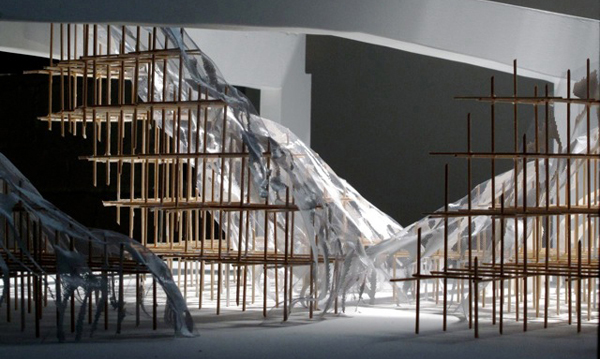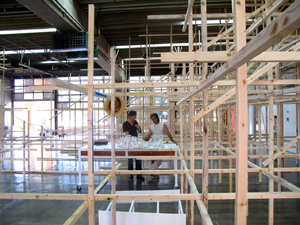Ephemeral Tucson Topography

A detail of the “Untitled (Basin and Range)” model.
The full scale installation is Alois Kronschlaeger’s largest piece to date.
photo courtesy MOCA
The sun is bright and angled just barely past overhead at 2:30 p.m. on a mid-September afternoon. Rolling up to the Museum of Contemporary Art, I park facing a work truck and next to the red moca letters at the museum’s plaza edge.
The soundscape is cut intermittently by the whirrrrrrr zzzzzzzzzzz of an electric saw, the scent of wood dust dances sweetly on a languid breeze. I move slowly, a little beat up from physical therapy, but also to take in the visuals. Not knowing what to expect from an installation that will only allow 10 people in at a time to experience it – in a huge space that once housed fire trucks – has piqued the curiosity.
Five men and a woman are working with 12-foot long two by twos. Thousands of these wood strips are already assembled together in MOCA’s Great Hall, hundreds more lie in mostly tidy groupings. A few of the guys look up out of curiosity, fleetingly – there is a deadline to meet.
MOCA’s Executive Director Anne-Marie Russell enthusiastically discusses the exhibit, Untitled (Basin and Range) by NYC, Austria-born, installation artist Alois Kronschlaeger. “Alois conceived the concept while here last year as a resident artist.” Russell smiles, adding that many of the artists who come through MOCA are inspired by the landscape. “These aren’t landscape artists, but the desert landscape becomes incorporated in their work.”
Russell says, “Let’s go meet the guys,” and we make our way across the plaza where Kronschlaeger and Henry Kerr are diligently concentrating on the project. Kerr is also an artist and the Basin and Range construction crew leader. En route, Russell introduces me to Florencia Minniti, Alois’ wife and a smiling beauty who looks very Tucson in her t-shirt, skirt and straw hat.
I’m awestruck by the scale of this work and not sure where to begin with the questions, so we start with the numbers. “There’s 1500 two by twos,” Kerr details. “This is recycled wood from three different, previous (MOCA) exhibits.”

Alois Kronschlaeger and Henry Kerr discuss the strategy for construction,
using the scale model as a reference.
photo from AloisKronschlaeger.wordpress.com
The installation depicts mountain ranges, comprised of 65 sections. Kronschlaeger, grinning and glistening with sweat, recounts the history. “I was here for nine days, in January 2012. I saw the (Great Hall) space, and went back to New York to build a model.”
Building the model alone took two months, six weeks of that was spent focusing on how to divide up the space. By the time the exhibit opens on Oct. 4, it will have taken about seven weeks of working 13 to 14 hour days, seven days a week, to construct it within the Great Hall.
“There are five ranges here,” Kronschlaeger continues, sweeping his arm back towards the Great Hall, which is filled to capacity with these wooden grids, still skeletal and awaiting definition. “Each has its own characteristics and attitude.
“What fascinated me was the topography, the basin and range of the landscape. I do site-specific work, so doing Tucson – it is the basin and range of the area.”
This is experiential art that navigates each individual through, under and around the ranges. It fires the imagination. What would it be like if we could actually move this way through mountain ranges? It is exciting and breathtaking.
Kronschlaeger asks if we should go through the ranges, I of course say yes, not realizing the ducking and dodging involved during this construction phase. Once the exhibit is completed, there will be free movement through the designated paths.
We take a break on the south end of the hall, and Kronschlaeger fleshes out the vision by explaining that the wood lattices – the ranges – will be draped with wire mesh that has a pouring of translucent paint on top.
“There are 10 rolls of mesh, each are six feet wide and 100 feet long,” Kronschlaeger explicates. “It’s a water-based acrylic paint, acting like an optic lens that mirrors the shifting of the light and the ambiance of the space.”
Each angle, every space, each moment, every perspective will be unique to each visitor based on the time of day. Since light shifts constantly as the Earth and Sun move in our solar system and universe, it is ephemeral defined.
Kronschlaeger’s blue eyes dance when he says, “It will take 75 gallons of paint,” as if to somewhat apologize for the quantity. Shrugging, he states with simple conviction, “Everything is in perfect alignment.”
Due to the limited viewing capacity, 10 people in the exhibit at a time, the Oct. 4 opening of Untitled (Basin and Range) is reserved for MOCA members. The general public can enjoy it starting on Oct. 5. MOCA is located at 265 S. Church Ave. Further details are available at MOCA-Tucson.org and (520) 624-5019. Also visit AloisKronschlaeger.wordpress.com to learn about the process of design and installation.
Category: Arts, DOWNTOWN / UNIVERSITY / 4TH AVE




